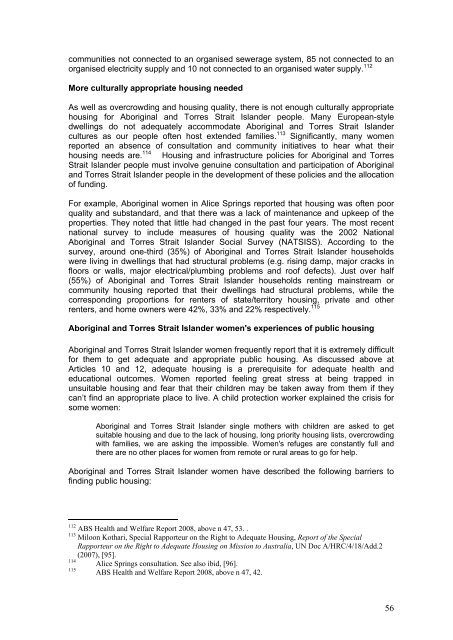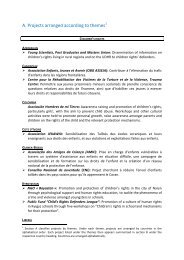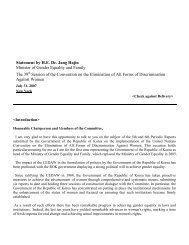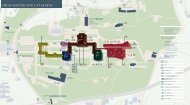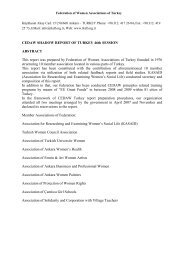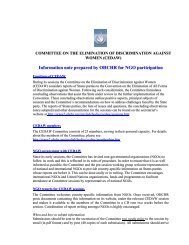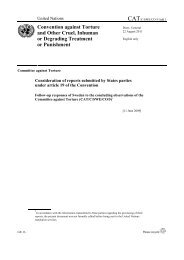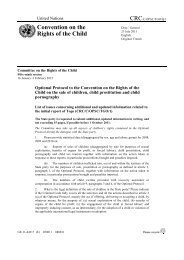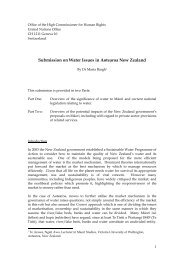Australian Aboriginal and Torres Strait Islander Women's Parallel ...
Australian Aboriginal and Torres Strait Islander Women's Parallel ...
Australian Aboriginal and Torres Strait Islander Women's Parallel ...
You also want an ePaper? Increase the reach of your titles
YUMPU automatically turns print PDFs into web optimized ePapers that Google loves.
communities not connected to an organised sewerage system, 85 not connected to anorganised electricity supply <strong>and</strong> 10 not connected to an organised water supply. 112More culturally appropriate housing neededAs well as overcrowding <strong>and</strong> housing quality, there is not enough culturally appropriatehousing for <strong>Aboriginal</strong> <strong>and</strong> <strong>Torres</strong> <strong>Strait</strong> Isl<strong>and</strong>er people. Many European-styledwellings do not adequately accommodate <strong>Aboriginal</strong> <strong>and</strong> <strong>Torres</strong> <strong>Strait</strong> Isl<strong>and</strong>ercultures as our people often host extended families. 113 Significantly, many womenreported an absence of consultation <strong>and</strong> community initiatives to hear what theirhousing needs are. 114 Housing <strong>and</strong> infrastructure policies for <strong>Aboriginal</strong> <strong>and</strong> <strong>Torres</strong><strong>Strait</strong> Isl<strong>and</strong>er people must involve genuine consultation <strong>and</strong> participation of <strong>Aboriginal</strong><strong>and</strong> <strong>Torres</strong> <strong>Strait</strong> Isl<strong>and</strong>er people in the development of these policies <strong>and</strong> the allocationof funding.For example, <strong>Aboriginal</strong> women in Alice Springs reported that housing was often poorquality <strong>and</strong> subst<strong>and</strong>ard, <strong>and</strong> that there was a lack of maintenance <strong>and</strong> upkeep of theproperties. They noted that little had changed in the past four years. The most recentnational survey to include measures of housing quality was the 2002 National<strong>Aboriginal</strong> <strong>and</strong> <strong>Torres</strong> <strong>Strait</strong> Isl<strong>and</strong>er Social Survey (NATSISS). According to thesurvey, around one-third (35%) of <strong>Aboriginal</strong> <strong>and</strong> <strong>Torres</strong> <strong>Strait</strong> Isl<strong>and</strong>er householdswere living in dwellings that had structural problems (e.g. rising damp, major cracks infloors or walls, major electrical/plumbing problems <strong>and</strong> roof defects). Just over half(55%) of <strong>Aboriginal</strong> <strong>and</strong> <strong>Torres</strong> <strong>Strait</strong> Isl<strong>and</strong>er households renting mainstream orcommunity housing reported that their dwellings had structural problems, while thecorresponding proportions for renters of state/territory housing, private <strong>and</strong> otherrenters, <strong>and</strong> home owners were 42%, 33% <strong>and</strong> 22% respectively. 115<strong>Aboriginal</strong> <strong>and</strong> <strong>Torres</strong> <strong>Strait</strong> Isl<strong>and</strong>er women's experiences of public housing<strong>Aboriginal</strong> <strong>and</strong> <strong>Torres</strong> <strong>Strait</strong> Isl<strong>and</strong>er women frequently report that it is extremely difficultfor them to get adequate <strong>and</strong> appropriate public housing. As discussed above atArticles 10 <strong>and</strong> 12, adequate housing is a prerequisite for adequate health <strong>and</strong>educational outcomes. Women reported feeling great stress at being trapped inunsuitable housing <strong>and</strong> fear that their children may be taken away from them if theycan’t find an appropriate place to live. A child protection worker explained the crisis forsome women:<strong>Aboriginal</strong> <strong>and</strong> <strong>Torres</strong> <strong>Strait</strong> Isl<strong>and</strong>er single mothers with children are asked to getsuitable housing <strong>and</strong> due to the lack of housing, long priority housing lists, overcrowdingwith families, we are asking the impossible. <strong>Women's</strong> refuges are constantly full <strong>and</strong>there are no other places for women from remote or rural areas to go for help.<strong>Aboriginal</strong> <strong>and</strong> <strong>Torres</strong> <strong>Strait</strong> Isl<strong>and</strong>er women have described the following barriers tofinding public housing:112 ABS Health <strong>and</strong> Welfare Report 2008, above n 47, 53. .113 Miloon Kothari, Special Rapporteur on the Right to Adequate Housing, Report of the SpecialRapporteur on the Right to Adequate Housing on Mission to Australia, UN Doc A/HRC/4/18/Add.2(2007), [95].114Alice Springs consultation. See also ibid, [96].115ABS Health <strong>and</strong> Welfare Report 2008, above n 47, 42.56


